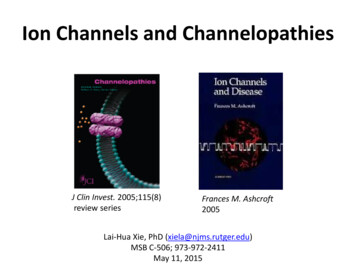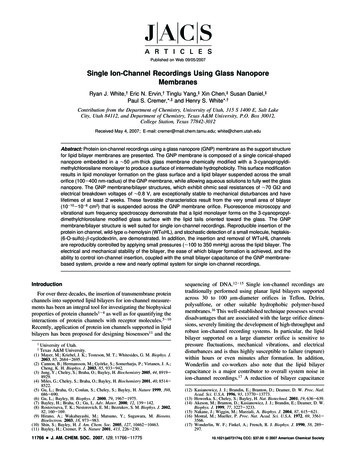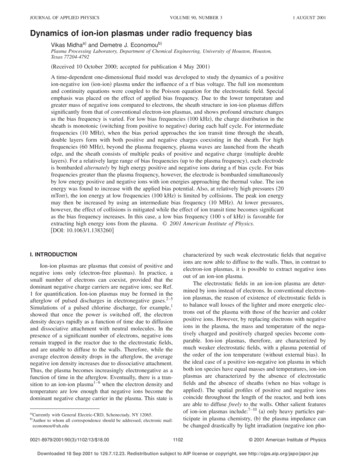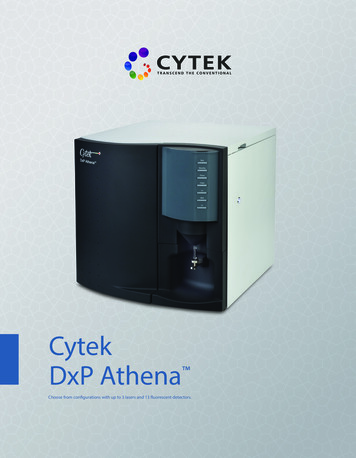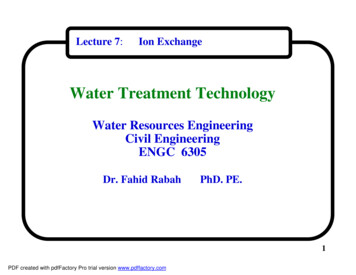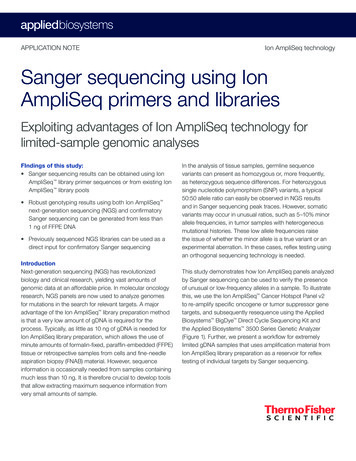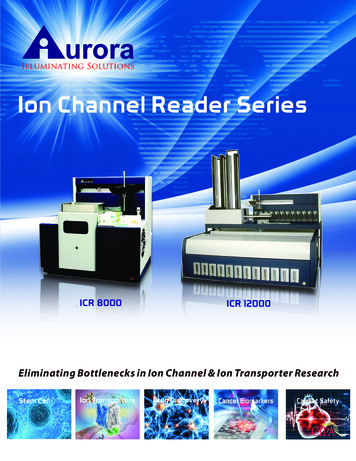
Transcription
Ion Channel Reader SeriesICR 8000ICR 12000Eliminating Bottlenecks in Ion Channel & Ion Transporter ResearchStem CellIon TransportersDrug DiscoveryCancer BiomarkersCardiac Safety
Ion Channel Reader SeriesAurora’s Ion Channel Reader Series (ICR series) combine atomic absorption spectroscopy (AAS) with a patentedmicrosampling technology to accurately measure ion movement in a cell-based assay format. This technology has beendeveloped with the capability of measuring activity of voltage-gated and ligand-gated ion channels, co-transporters andpumps. It is considered an effective and high throughput solution to investigate a broad range of membrane proteins includingelectroneutral targets, to which conventional electrophysiology cannot be applied.The ICR series detect ion movements across membrane proteins through quantifying intracellular and extracellular ionconcentrations of interest using AAS. This is a technique that is independent of, and complementary to methods that rely onvoltage manipulation. Since ion flux is a direct measure of channel activity, such assays are robust and less sensitive todisturbances. Data generated by the ICR Series are very consistent and predictive of drug potency.Figure 1.The IC 50 values obtained from 15 compoundsusing the Rb flux method and manual patch clampshow a R 2 value of 0.83 (unbroken line). The broken lineis for reference only.Table 1. Consistent drug potency ranks have been established using the ICR Series and radioactive rubidium method.Test CompoundICR 8000 TMIC 50 (µM)ICR 12000 TMIC 50 (µM)RbIC 50(µM)Same Rank order forall 3 4371.761.605.9346534004.185.1612.04Principle of Ion Flux Assay86
The procedure of setting up a flux assay is similar across all ion channel families. Cultured cells are first loaded with Rb (oranother tracer ion) and incubated overnight in a standard condition. This is followed by Rb removal from the extracellular fluidusing a wash buffer deprived of Rb . The compound of interest is then added into the wash buffer at a desirable concentrationand incubated for an optimized time period. Activation of the ion channel under study then leads to Rb efflux into the cellsupernatant due to the established concentration gradient for this tracer ion. For voltage-gated channels this can beaccomplished by adding a depolarizing buffer to the cells and for ligand-gated channels by adding the appropriate ligand. Tomeasure the effect of potential channel modulators, both cell supernatant and lysate are collected with their tracer ion contentmeasured by the ICR series. Ion efflux can be expressed as a ratio between extracellular and overall tracer ion content, thuseliminating potential well-to-well differences in cell densities and Rb loading.Dose Response Curves Generated by the ICR SeriesFigure 2. Rb Flux Assay on hERG.hERG antagonists astemizole, cisapride, MK-499 andsertindole displaying concentration-dependant channelinhibition effect in CHO-hERG cells.Figure 3. Li Flux Assay on Nav1.7Nav1.7 inhibition curves for TTX ( ), tetracaine ( ), andlidocaine ( )in Nav1.7 stably expressing HEK293 cells.Figure 4. Rb Flux Assay on NKCC1.Concentration-dependant inhibitory effect of bumetanideon NKCC1 Rb influx activated for 2 min ( ), with positivecontrol of 30μM bumetanide ( ), and negative controlswith absence ( ) and presence of 1 μM of digoxin ( ).
Applicable Ion Channel & Transporter TargetsUsing non-radioactive assay as a screening tool of membrane protein modulators is well-documented in scientific literature andhas been widely used for studying the potassium channel family. It is developed to circumvent problems associated with theshort-half life and high-energy emission of radioactive 86 Rb, while maintaining the information content and accuracy of theradioactive method. Rubidium is the most commonly used tracer ion to study potassium channels because of its similar physicalproperties to K , little natural presence in physiological systems, and ease to detect by AAS. The principle of the non-radioactiveRb assay can be easily applied to other membrane protein targets as well.Tracer IonRb Ag Li2 Applicable TargetsPotassium Channels/Transporters: hERG, KCNQ2, Kv1.1, Kv1.3, Kv1.4,Kv1.5, Kir6.2, B/SKCa, Slack, K ATP , NKCC1, Na ,K ,-ATPase and moreChloride Channels/Transporters: KCC2, TMEM16A, CFTR and more Sodium Channels: Nav1.2, Nav1.5, Nav1.7 and moreCa /Sr2 Table 2. The application offlux assay is not limited tostudying potassium channelactivities. Other tracer ionsincluding Ag , Li , Ca 2 andpotentially more can be usedto screen against differenttargets in a flux assayformat on the ICR series.Calcium Channels: Cardiac L-type and moreComparison Between Available Screening TechnologiesThere are several alternative methods widely available for assessment of ion channel activity. However, only the ICR series candeliver unparalleled speed, precision and SensitivityAccuracyCommentsICR 8000MediumMediumHighMediumApplicable to K , Na , Cl - , Ca 2 channelsand transportersICR 12000MediumHighHighMediumSame as ICR t amenable to electro-neutral targetsBinding AssaysLowHighMediumLowRequires radio-labeled probe specificfor targetRadioactive FluxAssaysMediumMediumMediumMediumShort half-life and exposure concernsFluorescent ImagingLowHighMediumLowProne to dye artifacts, high cost ofconsumables & high background noise
Reference PublicationsThe ICR Series are utilized as a tool to facilitate any ion channel and transporter research or screening where the measurement of ion movementprovides meaningful insight into channel activity. The same principle of flux assay is amenable to studying more membrane protein targets thancurrently validated. Major pharmaceutical companies are especially in favour of the ICR given its automated workflow and high throughput.Academic institutions find that this technology provides reasonable data output at a low operating cost.Functional Analysis of LargeConductance Ca2 - Activated K ChannelsScreening of KCNQ2 PotassiumChannel ModulatorsThe pharmacological profiles of BK(Ca) channels assessed by AAS (A) comparewell with those obtained using the Rb efflux assay (B).Testing 80 ion channel modulators for activity against KCNQ2. The solid line representsthe average % efflux of all samples. The dashed line represents 20% inhibition ofstimulated efflux.Consistent Data Between Efflux Assayand Manual Patch Clamp Data on hERGChannelsUsing Ag as a Tracer Ion to StudyModulators of Cl - ChannelsMeasurement of Rb efflux is a reliable and accurate method for predicting thepotency of compounds (IC 50 values) blocking hERG channels.AAS-based detection system for high throughput screening of CaCCmodulators. Cl - flux from CHO cells transfected with TMEM16A is assayedindirectly, by measuring excess Ag ions in the supernatant of AgClprecipitate. The assay can be easily extended to study modulators of other Cl channel subtypes.Measurement of Potassium Channel Activity in hESC-Derived Stem Cell ModelsKATP channel activity was determined by measuring Rb efflux over time.hESC-derived cells were not responsive to either KATP channel inhibitors(glibenclamide and glucose) or activators (metabolic inhibitors:oligomycin and 2-deoxy-D-glucose). In contrast, KATP channel activity inMIN6 β-cells was appropriately stimulated by metabolic inhibitors andinhibited by the addition of glibenclamide; both glibenclamide andglucose inhibited channel activity in another β-cell line, beta-TC3 cells.
Novel Perspectives of Ion Channel ResearchI on channels and transporters are a new class of membrane proteins aberrantly expressed in several types of human cancers.Besides regulating different aspects of cancer cell behavior, they can now represent novel cancer biomarkers. The University ofFlorence summarized how ion channels and transporters exert their functions in breast, prostate, lung, colorectal, esophageal,pancreatic and gastric cancers.SpecificationsICR 8000 TMICR 12000 TMThroughputUp to 5000 wells/dayUp to 60000 wells/dayMinimum Sample Volume50μL20μLFootprint (cm)H67 W55 D37H120 W95 D37Sensitivity0.05ppm detection limitPrecision 5% CVReferencesA. S., Groebe, D. R., Scott, V. E., Feng, J., Zhang, X., Warrior, U., . . . Shieh, C. (2003). Functional Analysis of Large Conductance Ca2 -Activated K Channels: Ion Flux Studies by Atomic Absorption Spectrometry.ASSAY and Drug Development Technologies, 1(5), 647-654. doi:10.1089/154065803770381002Bruin, J. E., Erener, S., Vela, J., Hu, X., Johnson, J. D., Kurata, H. T., . . . Kieffer, T. J. (2014). Characterization of polyhormonal insulin-producing cells derived in vitro from human embryonic stem cells. Stem CellResearch, 12(1), 194-208. doi:10.1016/j.scr.2013.10.003Karczewski, J., Wang, J., Kane, S. A., Kiss, L., Koblan, K. S., Culberson, J. C., & Spencer, R. H. (2009). Analogs of MK-499 are differentially affected by a mutation in the S6 domain of the hERG K channel.Biochemical Pharmacology, 77(10), 1602-1611. doi:10.1016/j.bcp.2009.02.011Lastraioli, E., Lottini, T., Bencini, L., Bernini, M., & Arcangeli, A. (2015). HERG1 Potassium Channels: Novel Biomarkers in Human Solid Cancers. BioMed Research International, 2015, 1-9.doi:10.1155/2015/896432Qi, J., Wang, Y., Liu, Y., Zhang, F., Guan, B., & Zhang, H. (2014). Development and validation of HTS assay for screening the calcium-activated chloride channel modulators in TMEM16A stably expressed CHOcells. Analytical and Bioanalytical Chemistry, 406(6), 1713-1721. doi:10.1007/s00216-013-7550-5Rezazadeh, S. (2004). Rb Flux through hERG Channels Affects the Potency of Channel Blocking Drugs: Correlation with Data Obtained Using a High-Throughput Rb Efflux Assay. Journal of BiomolecularScreening, 9(7), 588-597. doi:10.1177/1087057104264798Scott, C. W., Wilkins, D. E., Trivedi, S., & Crankshaw, D. J. (2003). A medium-throughput functional assay of KCNQ2 potassium channels using rubidium efflux and atomic absorption spectrometry. AnalyticalBiochemistry, 319(2), 251-257. doi:10.1016/s0003-2697(03)00328-2Stankovich, L., Wicks, D., Despotovski, S., & Liang, D. (2004). Atomic Absorption Spectroscopy in Ion Channel Screening. ASSAY and Drug Development Technologies, 2(5), 569-574. doi:10.1089/adt.2004.2.5691001 East Pender StreetVancouver, British ColumbiaCanada V6A 1W2Terstappen, G. C. (2004). Nonradioactive Rubidium Ion Efflux Assay and Its Applications in Drug Discovery and Development. ASSAY and Drug Development Technologies, 2(5), 553-559.doi:10.1089/adt.2004.2.553Trivedi, S., Dekermendjian, K., Julien, R., Huang, J., Lund, P., Krupp, J., . . . Bostwick, R. (2008). Cellular HTS Assays for Pharmacological Characterization of NaV1.7 Modulators. ASSAY and Drug DevelopmentTechnologies, 6(2), 167-179. doi:10.1089/adt.2007.090Wen, Y., Roth, D., Enderle, T., Gill, S., Gill, R., Liang, S., & Liang, D. (2016). Development of Rubidium Flux Assay & HTS Campaign for Modulators of a Cation-Chloride Co-transporter , accessed April 27, nsporter YangWen 2016.pdf.Phone: 1(604)-215-8700Email: info@aurorabiomed.comWebsite: www.aurorabiomed.com
Aurora's Ion Channel Reader Series (ICR series) combine atomic absorption spectroscopy (AAS) with a patented microsampling technology to accurately measure ion movement in a cell-based assay format. This technology has been developed with the capability of measuring activity of voltage-gated and ligand-gated ion channels, co-transporters and pumps.

